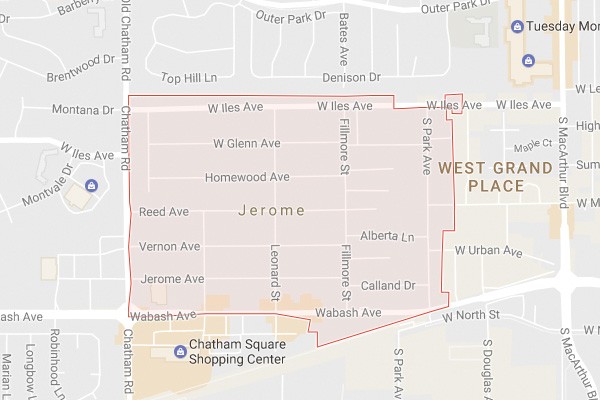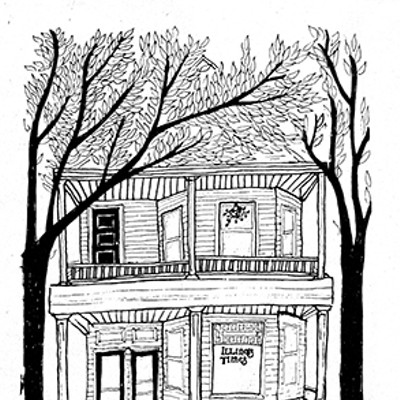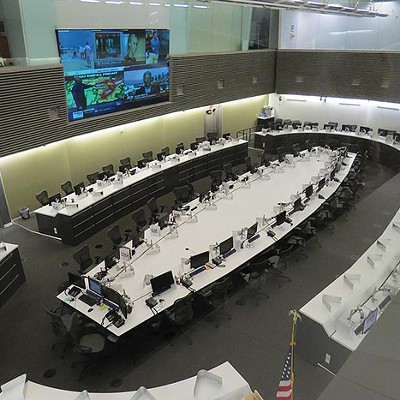Marrying for money
How might struggling toy towns like Jerome survive?
[
{
"name": "Air - MedRect Combo - Inline Content 1",
"component": "11490391",
"insertPoint": "3",
"requiredCountToDisplay": "1",
"parentWrapperClass": "fdn-ads-inline-content-block"
},{
"name": "Air - MedRect Combo - Inline Content 2",
"component": "11490392",
"insertPoint": "7",
"requiredCountToDisplay": "5",
"parentWrapperClass": "fdn-ads-inline-content-block"
},{
"name": "Air - MedRect Combo - Inline Content 3",
"component": "11490393",
"insertPoint": "12",
"requiredCountToDisplay": "9",
"parentWrapperClass": "fdn-ads-inline-content-block"
}
]
I hear that Jerome had to lay off its police chief. What, you didn’t know that Jerome had a police chief? Or that Jerome had a police department? Or that Jerome needed a police department? The village is home to only 1,651 people. As for the ability of its tax base to support the full spectrum of modern municipal services, if the freezers at Shop ’n’ Save break down for a week, Jerome would have to lay off a clerk.
Why did this agglomeration of very modest subdivisions (West Grand, Leland Highpoint and Alta Sita) in unincorporated Woodside Township undertake the perils of village-ness? For the answer we must go back to the 1930s. The City of Springfield, thanks to Commissioner Willis J. Spaulding, had a spanking new water system that delivered what he invariably described as “sparkling” water. This was a near-miracle; the only thing harder to swallow than Springfield’s politics over the years had been its water. Folks in the unincorporated parts of Sangamon County were still drinking water from holes in the ground. They’d never seen water that sparkled except in the movies, and they wanted some.
Springfield was willing to sell it to them, but how to deliver it? Or rather, how to pay for laying the new mains needed to deliver it? Washington was funding new water systems through the anti-Depression Work Projects Administration, which paid for labor. Locals were responsible for the rest. Unincorporated areas next to the city were connecting to Springfield’s mains, the city recovering part of the costs by assessing residents roughly a buck a lineal foot of pipe. But supplying the future Jerome would take a lot of pipe. (The neighborhood named itself Jerome because it sat on the farm that had belong to Jerome Leland, whose land it once was, and the area was still quasi-rural.) The residents would have to borrow to pay their part of the costs, and selling revenue bonds required that they band together as a corporate entity.
Thus the rush in 1939 to incorporate themselves as villages by citizens who were eager to enjoy modern municipal amenities but preferred that someone else help pay for them. The voters who created Jerome were joined that year by voters in what became Southern View and Grandview. (Residents on the east side rejected a plan to become a new village of Bergen.) Rochester, already a town, also used WPA money to build mains to connect to Springfield.
Some 40 years later, the then-president of the Jerome board would complain that the village had been coerced, that Spaulding had forced a “no incorporation, no water” policy on places like Jerome. “There probably never would have been a Jerome, a Southern View, or a Grandview had it not been for Willis Spaulding’s insistence on corporations,” he said. He didn’t explain how, exactly, putting taxable land on its fringes beyond the grasp of Springfield would have been in the big city’s interest. Spaulding himself, I suspect, didn’t care how people moved his water as long as they paid for it. The president went on to say that Jerome residents “incurred significant indebtedness (now paid) to purchase its water mains.” Well, boo-hoo. Who else should have paid for Jerome’s mains but Jerome?
These villages were not the only ones to create themselves to get the things that villages or towns can provide. In the case of Leland Grove, that thing was streets. In 1950 for example, the Springfield Transportation Company, the private predecessor to the SMTD, which had been running a trial extension of service down Noble Avenue, complained in a hearing that that the pavement on Noble Avenue was so rough that it was beating up its buses.
If the future Leland Grove (basically the Oak Knolls subdivision) were to incorporate as a city, it could collect its share of taxes then going to Woodside Township and the state (through gas taxes) and levy its own motor vehicle taxes. Such riches would allowed the new “city” (in Illinois it’s a legal classification, not an urbanistic one) to “pull the district out of the mud.” So it did, barely; Leland Grove built only ”semipermanent” streets (mainly oil-and-chip) equipped not with sewers but drainage ditches.
There are hundreds of toy towns like these around Illinois. Like special purpose districts and too-small counties and school districts, they duplicate services and waste money and most experts think they ought to be consolidated or otherwise put out of business. The sensible thing for a financially struggling Jerome to do would be to annex itself to the City of Springfield, put up a sign on the old village border announcing itself an historic worker cottages community and begin the paperwork for historic preservation tax breaks. The same is true of Southern View, Grandview and Leland Grove.
Ah, but Springfield tried to annex the Grovers in 1957 and failed emphatically. Annexation was talked about in 1960 and again in 1971 and voted on in 1976. But since state law requires that both parties to such annexations agree, it never happened. I don’t see it ever happening until these towns have no choice. The City of Springfield does not make a prepossessing suitor these days – you might as well ask your daughter to marry the guy who lives under the bridge – but many worse marriages have been made for money.
Contact James Krohe Jr. at [email protected].
Why did this agglomeration of very modest subdivisions (West Grand, Leland Highpoint and Alta Sita) in unincorporated Woodside Township undertake the perils of village-ness? For the answer we must go back to the 1930s. The City of Springfield, thanks to Commissioner Willis J. Spaulding, had a spanking new water system that delivered what he invariably described as “sparkling” water. This was a near-miracle; the only thing harder to swallow than Springfield’s politics over the years had been its water. Folks in the unincorporated parts of Sangamon County were still drinking water from holes in the ground. They’d never seen water that sparkled except in the movies, and they wanted some.
Springfield was willing to sell it to them, but how to deliver it? Or rather, how to pay for laying the new mains needed to deliver it? Washington was funding new water systems through the anti-Depression Work Projects Administration, which paid for labor. Locals were responsible for the rest. Unincorporated areas next to the city were connecting to Springfield’s mains, the city recovering part of the costs by assessing residents roughly a buck a lineal foot of pipe. But supplying the future Jerome would take a lot of pipe. (The neighborhood named itself Jerome because it sat on the farm that had belong to Jerome Leland, whose land it once was, and the area was still quasi-rural.) The residents would have to borrow to pay their part of the costs, and selling revenue bonds required that they band together as a corporate entity.
Thus the rush in 1939 to incorporate themselves as villages by citizens who were eager to enjoy modern municipal amenities but preferred that someone else help pay for them. The voters who created Jerome were joined that year by voters in what became Southern View and Grandview. (Residents on the east side rejected a plan to become a new village of Bergen.) Rochester, already a town, also used WPA money to build mains to connect to Springfield.
Some 40 years later, the then-president of the Jerome board would complain that the village had been coerced, that Spaulding had forced a “no incorporation, no water” policy on places like Jerome. “There probably never would have been a Jerome, a Southern View, or a Grandview had it not been for Willis Spaulding’s insistence on corporations,” he said. He didn’t explain how, exactly, putting taxable land on its fringes beyond the grasp of Springfield would have been in the big city’s interest. Spaulding himself, I suspect, didn’t care how people moved his water as long as they paid for it. The president went on to say that Jerome residents “incurred significant indebtedness (now paid) to purchase its water mains.” Well, boo-hoo. Who else should have paid for Jerome’s mains but Jerome?
These villages were not the only ones to create themselves to get the things that villages or towns can provide. In the case of Leland Grove, that thing was streets. In 1950 for example, the Springfield Transportation Company, the private predecessor to the SMTD, which had been running a trial extension of service down Noble Avenue, complained in a hearing that that the pavement on Noble Avenue was so rough that it was beating up its buses.
If the future Leland Grove (basically the Oak Knolls subdivision) were to incorporate as a city, it could collect its share of taxes then going to Woodside Township and the state (through gas taxes) and levy its own motor vehicle taxes. Such riches would allowed the new “city” (in Illinois it’s a legal classification, not an urbanistic one) to “pull the district out of the mud.” So it did, barely; Leland Grove built only ”semipermanent” streets (mainly oil-and-chip) equipped not with sewers but drainage ditches.
There are hundreds of toy towns like these around Illinois. Like special purpose districts and too-small counties and school districts, they duplicate services and waste money and most experts think they ought to be consolidated or otherwise put out of business. The sensible thing for a financially struggling Jerome to do would be to annex itself to the City of Springfield, put up a sign on the old village border announcing itself an historic worker cottages community and begin the paperwork for historic preservation tax breaks. The same is true of Southern View, Grandview and Leland Grove.
Ah, but Springfield tried to annex the Grovers in 1957 and failed emphatically. Annexation was talked about in 1960 and again in 1971 and voted on in 1976. But since state law requires that both parties to such annexations agree, it never happened. I don’t see it ever happening until these towns have no choice. The City of Springfield does not make a prepossessing suitor these days – you might as well ask your daughter to marry the guy who lives under the bridge – but many worse marriages have been made for money.
Contact James Krohe Jr. at [email protected].
Illinois Times has provided readers with independent journalism for almost 50 years, from news and politics to arts and culture.
Your support will help cover the costs of editorial content published each week. Without local news organizations, we would be less informed about the issues that affect our community..
Got something to say?
Send a letter to the editor and we'll publish your feedback in print!





















